Winter
Lakes & Pond Winterization
Maintaining
fish ponds and lakes during winter for improved water quality and
fish survival.
I
don't know how many times I've helped someone set up an aeration system
and when I finish sinking the last diffuser and the bubbles are rippling
their glorious boil on the surface my client, bless his heart, will
ask me if that's all their is to it!
Let's back up the koi train a few stops! An aeration system is something
that most anyone who venture into the project of building a pond understands
is extremely important and key element in but so many people think
the movement of water as circulation and the bubbler aerator system
is something that is required in summer only!
Winter
pond care is a whole new dimension for many people who would like
to think that when the snow and freezing temperatures lock their ponds
and lakes in to a frozen block that all they need to worry about is
the sharpness of their ice-skates and how to build a homemade zamboni!
Of course aeration and circulation is critical in summer when the
transfer of oxygen is so high and the stratification of temperature
and elemental layers of the pond are their most severe.
But what happens when the winter comes is that the surface freezes
and the oxygen can't be absorbed by the water as readily when the
surface is in a liquid state.
Ice forms a hermetically sealed cover over a lake and just like wrapping
a good sandwich in saran wrap it can preserve what's inside but it
can also create conditions that lead to health problems...for the
pond and the hero submarine!
The ice can cause the fish; Koi fish, trout , carp or catfish, to
be deprived of oxygen but even worse, the ice can cause trapped gasses
to be held inside the pond. Imagine breathing into a plastic bag!
The life giving sustenance of the pond under closed ice is lessened
and the fish soon become lethargic, and die. Winter fish kills can
be a catastrophic loss for a pond owner or aquaculturealist.
Pond
Heaters & Deicers
For large bubblers and dock de-icers see our bubbler
and de-icer page
Ice
Eater® Dock Bubbler Deicers 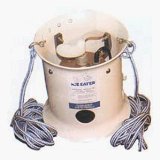
The
most energy efficient dock deicer is the Ice Eater® which
uses a patented design and PVC flow director that circulates
water to the surface, causing turbulence that reduces or eliminates
ice formation around docks. More
info
Kasco
Agitator Thrust Deicers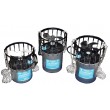
Mounted in either a vertical or horizontal
position, the de-icer circulates water to the surface, causing
turbulence that reduces or eliminates ice formation. More
info |
Bubbler
Hose
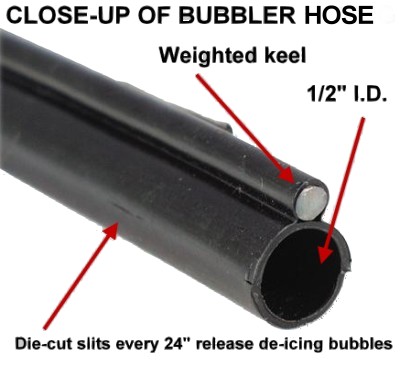 Weighted
de-icer airhose/bubbler tube for deicing small and large areas.
Weighted 1/2" I.D. tubing requires only 1 CFM per 100 feet (0.01
CFM per foot). Single runs of up to 200' can be used with even
bubble flow. More
info.
Weighted
de-icer airhose/bubbler tube for deicing small and large areas.
Weighted 1/2" I.D. tubing requires only 1 CFM per 100 feet (0.01
CFM per foot). Single runs of up to 200' can be used with even
bubble flow. More
info. |
Dock
Bubbler Packages
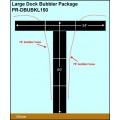
Pond bubbler deicer packages suitable for protecting docks,
boathouses, seawalls, boat lifts and houseboats.
More
information
Diffused
Air De-Icer Bubblers
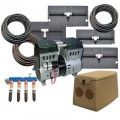
When using surface
agitaors or linear bubbler hose as a bubbler system is not practical
or too costly the diffused air de-icing systems can be installed
eaily and provide effective protection from ice damage.
More
information
|
Beyond the fish,
a pond without a proper bubbler or de-icer hole accumulations of organic
waste from falling debris such as leaves and nutrient runoff from
gardens and nearby fertilization sources and the buildup can create
putrid gasses that collect on the pond floor and create issues of
algae growth and odors in the Spring. Another reason to add a deicer
or pond heater to a pond.
When you want to aerate a pond you are usually looking at the needs
of a pond during the warm pond season which is usually from April
through October in North America and of course, as I've been told,
quite different in the Southern Hemisphere...when I was in Australia
in January I saw some wonderful ponds and in December in Hawaii they
showed off some of the most incredible flowering koi ponds I have
ever seen.
The chemical reactions and biological needs of a pond in winter are
about 20 percent less than what would be required in a fully operational
summer pond or lake. If you operate, for example, a summer pond or
lake circulator with 4 diffusers being fed by an air pump, shore mounted,
delivering say 10 CFM at a pressure of 5PSI to 10 PSI then you would
need only one diffuser and maybe 2 CFM during winter to ensure that
there was no buildup of nitrites, ammonia, or other complicating elements.
If your pond is in an area where a wide gaping hole in the ice is
acceptable and will not be a danger to migrating deer, snowmobiles,
cross-country-skiers on your pond, animal or pet trail migrations
or figure skating children or relatives who enjoy hockey on the pond
then you can consider a simple and cheap bubbler type of de-icer.
In smaller ponds when there is an an electrical outlet near the shore,
preferably mounted on a post, you can plug in an electric de-icer.
In larger ponds it is often easier to buy a system that has a long-lasting
oil-free compressor that can deliver the appropriate cubic feet per
minute of air to the diffuser (usually about 1 to 4 CFM) which will
mean a single self-sinking diffuser causing bubbles to maintain a
hole in the ice.
Believe it or not but it is not desirable to open too large of a hole
in the pond as this can result in the super-cooling or overcooling
of a pond which means that the movement of the pond is so great that
the water is losing all it's heat through contact with the cold atmosphere
and can literally turn to a slushy coagulated mess killing fish and
causing more damage than good...well maybe that's a bit dramatic but
still!
Tips
For Preparing a Gold Fish or Koi Pond For Winter
The frozen winter season can be tough on a prized koi or goldfish
pond, and it is essential to start preparing for winter a couple
of months in advance which usually means you have to think about
the BactaPUR Pond treatment which is a cold water bacteria in about
August if you live in Canada and maybe October if your pond is below
of the 49th parallel!
The basic steps
for winterizing your fish pond, a small one with koi or goldfish
are:
— Change your fish feed to one with less percentage of protein
and higher levels of carbohydrates. This will help increase their
fat reserves, which will give them more energy over Winter. If the
water temperature drops below 10 Celsius, stop feeding them altogether.
Remember the fish metabolism slows to a turtles pace in winter so
they don't need the regular growth inducing levels of feed bringing
them to the surface with their puckered mouths gaping for handouts!
— Clean the pond. A lined pond or a pre-formed pond should
have regular muck removal or vacuuming via a pond suction device
which will skim and remove the thick organic material from the bottom
of the pond that clings to the pond rocks and walls (the mucky stuff
in the pond includes dead plant material and goldfish droppings).
If it is humanly possible it would be ideal to remove the fish from
the pond, drain all the water, clean the bottom of the pond, and
replace the fish in clean water. Make sure you don't set your prized
Japanese Koi in a bucket near the kitchen or you may find someone
has decided to make a "special fisherman's special" supper.
Oh My!
— In the pond... cut away dead or dying leaves on aquatic plants.
Some shoreline plants and the invasive species may require more
severe pruning, so get appropriate tools from us and use the best
aquatic garden tools.
— If your pond has leaves from surrounding trees falling into
it, place a fine leaf-net over the surface of the water to catch
falling leaves. This helps keep the leaves out of the pond which
is best as the decomposing leaves remove oxygen which can reduce
available oxygen for your fish!
— Put a hiding place for the goldfish in the pond. Winter is
hard on the birds and predators that eat fish too, and they will
take an easy meal if it is available. . While some cheapskates use
an upside-down flower pot as a fish protection device a more ecological
choice would be a floating island or a floating islandscape which
are plantable floating structures that can offer great protection
for fish but without dumping homemade Styrofoam plastic homemade
planters or pots to protect your fishy friends!
Getting
Ready For Winter & The Pond
Yep...just
like the annual switching of the all-seasons to studded winter tires
every single year, as summer ends and the weather gets colder and
we head towards winter people come by my house and we sit by the
pond having a last-minute bar-b-que under the crimson and orange
leaves and as I hear the little voice in my head as do I really
know how to how to prepare my ponds for winter?
I mean,
I've had the darned thing for fifteen years and what started out
as a backyard hole with a pre-formed molded pond has turned into
a series of waterfalls and ponds that are scattered near the large
earth pond in what must look like crop-circles from the air and
every November I see the plants going dormant, the irises and lilypads
turning brown and warning me that it's time to get the winter pond
checklist out of the closet!
The entire pond including the fish and plants need their own special
care and have very different needs in the winter which require you
to ensure specific treatments. When the water temperature of the
pond, try and measure the temperature not right near the surface
or near the shore as it is always several degrees warmer that the
deeper areas, is around 10 degrees Celsius or 50 degrees Fahrenheit
you will start to see your fish start to lose interest in food and
at this stage it is best to only feed them 2 or 3 times per week.
When the temperature is around 41 degrees Fahrenheit or 5 degrees
Celsius you should stop feeding them all-together. Goldfish and
Koi as do not really not need to eat during the winter as their
bodies metabolism slows down and their metabolic rate is reduced
so it , it can actually be bad for them to be fed during these cold
months! Even trout, carp, bass and other lake and large pond fish
don't need to be fed anymore. I know most folks, unless they are
real hard-core fisherman and use automatic feeders to keep their
stock plump, don't feed most species but if you are feeding your
stock it is best to reduce and then stop for winter.
Fish health in
their internal organs requires certain enzymes and bacteria in the
digestive tract to break down the fish food properly and while these
naturally secreted enzymes and bacteria flourish in the warm months,
their levels quickly start to decrease when the pond water temperatures
start to drop which means that food given in cold temperatures when
these enzymes are not being produced can pass through the digestive
tract completely undigested, and potentially cause dangerous blockages
or even start to decay inside the core of the fish.
So do your fish a favor and resist the urge to keep feeding them.
I know how bad I felt when I ate too much of Rose's Super-Bowl Chili
last January and was blocked up for a week! I'd hate my prized goldfish
to live through such pain!!
Now I'm not a maniac when it comes to fish, I have a few but that's
not the raison d'être of my ponds. I have had some lessons
in fish survival mostly learned the hard way when I've had fish
kills or seen the ice melt and watch in sadness as there was no
life left in the fish...for this reason I try and resist giving
my fish names anymore...but I still do because my fish are like
my pets! Now there are some wheat germ based fish foods and special
spring and fall foods that are formulated for easy digestion to
allow you to continue feeding later in to the fall and start spring
feeding earlier but even these foods they should only be used in
cooler water temperatures a couple times a week, and should also
be stopped in water temperatures below 40 degrees F or 5 degrees
C.
Fish,
like most of my family on my Papa's side, have plenty of fat stored
up in their body from their summer-long feasting to last them through
until Spring as long as the other important element in keeping the
fish healthy over the winter is addressed and that is is to provide
adequate gas exchange in the pond. This simply means providing an
outlet for toxic gasses to escape through the ice as the organic
pond debris like leaves and plants and fish waste starts to decompose.
This also means allowing oxygen to enter the water for the fish.
How can we perform all of these operations? Well...let me put it
simple...you need to keep a hole in the ice! Yep; a bubbler, a pond
heater, a running pump or a homemade lightbulb in a wooden box floating
on air-filled floaters will do the trick but the key is to ensure
a hole in the ice for gases to escape and oxygen to get to the fish.
In shallow ponds the ice can get quite thick and if the pond freezes
in to a solid mass it will be a disaster for the fish. Beyond giving
your fish fresh air having a bubbler or an electric pond heater
also allows an pond without fish to remain healthier. The decaying
leaves upon decomposition release potentially toxic gases and unwanted
elements into the pond; this can lead to that stinky sulfur smell
and a buildup of black odorous muck. Having a chimney to vent out
gases is a great way to keep things clean upon ice dispersion in
Spring.
For smaller ponds a floating pond de-icer is a easy to install and
cheap bubbler alternative. They usually have only 10 to 20 feet
of power cord so they are used mainly in backyard ponds, patio ponds
or in ponds where having a hole near the shore is adequate. They
don't add any extra oxygen so it might be recommended to add a small
aerator or bubbler in one area of the pond along with the pond heater
or thermo-pond de-icer.
Some pond owners like to leave their pumps and filter boxes running
all winter, and while you may get away with this in southern states
or in warmer winters but I recommend that the pump and filter be
shut off in most cases mainly because if your submersible pump is
at the deep end you will be cooling off those deep waters as the
water is pumped towards the cold air and you can sometimes super-cool
your pond to the point where it is only slightly above freezing
and can turn into a veritable slushy inhospitable gel for your fish.
The other reason
I prefer to stop the filter and skimmer in winter is to do maintenance
and clean all filters and ensure the circulation system will have
a longer life. If the power goes out and your pump gets damaged
or freeze and your filter stays uncleaned and gets clogged you might
just end up burning out an expensive submersible pump.
It is no fun to try and perform maintenance on a filter in the cold
weather, so most people neglect cleaning the filter if they leave
it operating from December through March and the filter will ultimately
have a tendency to clog which will put an excess strain on your
pump. Now even worse, in the case of one of those external pressurized
biological filters, a power failure during a frigid period where
temperatures are below freezing can cause the pump to stop and the
filter to freeze and crack because it is full of water. That's a
costly repair and a risk you shouldn't take!
I leave the aquatic plants to my daughters who know more about identifying
every pond species in our yard...I can spot the different colors
but that's as far as my expertise on plants goes. Still, the girls
tell me that preparing pond plants for winter isn't really as tough
as I make it out to be.
Some plants do not over winter at all and must be thrown out and
these include most of the floating plants like water hyacinths,
water lettuce, floating fern, and any other non-potted floating
plants but even some potted plants like tropical water lilies must
be tossed on to the compost heap of and replaced in the spring.
Microbe-Lift
Winter Prep
Best
Price on Amazon
As affiliates
we may recieve payment for purchases made through Amazon.
Microbe-Lift
Autumn/Winter Prep is a specifically formulated beneficial
treatment to winterize your pond to prepare it for spring start-up;
Helps to maintain a healthy immune system for your fish during
the winter.
Autumn/Winter Prep accelerates the breakdown of leaves,
sediment and other organic matter during the fall and winter
months; This creates a clear and cleaner pond and a healthier
environment for pond life.
Autumn/Winter Prep is a two-part system of liquid bacteria
and dry, water soluble packets containing a blend of enzymes
and bacteria; The packets accelerate the breakdown of debris
and eliminates the initial by-products.
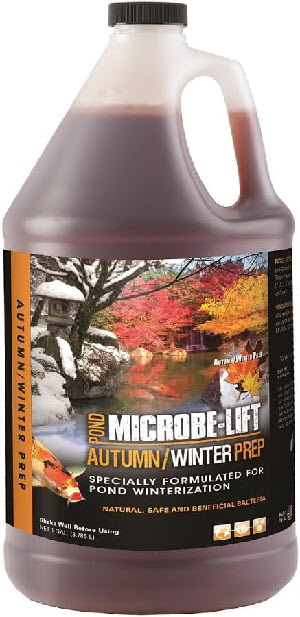
As an Amazon
affiliate we may recieve payment for purchases made through
Amazon. |
Almost all potted
plants do well and can survive over winter provided they are properly
prepared which mainly means taking the time to trim down the plants
as much as possible. This involves trimming or cutting all parts
of your plant that grows up above the level of the rim of the pot.
These extended parts of the plant if they are above the pot edge
will only die and decay in the pond in the winter, so it is best
just to trim it off.
Any hearty roots or plant tubers, which are well insulated in the
dirt, normally winter over and survive if they are kept below the
frost level of the pond. For this reason, we also recommend lowering
the pots down to the deepest part of the pond during the winter.
When your roots are exposed to extreme cold, they will just die
and need to be replaced, so if you want to keep them for next season
they should be at least 18 inches or 45 centimeters below the water
surface. Now guess what, adding that heater we talked about earlier
is going to help! Another reason to spend a few centers per day
in hydroelectric costs to keep those blooms blooming next April!
Stories From A Winter Goldfish Pond
I decided
to keep my five prized goldfish outside over the winter instead
of bringing them inside like we had originally planned. We thought
the cost of buying an aquarium for the goldfish would be too expensive
and thought that just keeping the goldfish outside in the pond would
be better.
We had bought a 100 Watt Pond Heater for the 125 gallon pond and
a 100 watt heater for the other 85 gallon pond. These floating deicers
worked great and we could see that there was open water in the small
hole in the floating unit so we though everything was fine.
One day we noticed
the fish swimming near the surface, and this was after the weather
had turned warm and all of the ice melted, so we wondered if they
were ok. The fish were near the surface sort of swimming on their
sides and really gasping for air but we didn't understand because
normally cold water can hold so much more oxygen and we figured that
since we were letting the gasses escape with the deicer that there
wouldn't be any issues.
We decided to
take a precautionary check of the pond water, we have a small water
testing kit, and were shocked to see the ammonia levels were through
the roof up to around 9 ppm which was close to lethal for the poor
fishes!
We added a small bubbler aerator airstone into the pond and let
it bubble up from the bottom and within a few days the water test
showed less than 1 PPM of ammonia and the fish looked much healthier
and were swimming so much more robustly!
So even if you use a deicer make sure you add the occasional circulation
with a bubbler to keep the stagnant waters in even a small pond
from making the fish sick. The surface tension on the pond can trap
ammonia, nitrites and nitrates as well and cause serious health
issues. We now always combine a floating deicer with a bubbler that
we use part time.
Winter
Shut Down Revisited
I know,
everyone tells me I often repeat myself but if you're like me you
need to hear something a few times before it sinks in to the old cranium!
So lets review what to do with pond plants: the plants you love and
cherish and hate to see eaten by muskrats deer and puppies are the
number one factor in creating decay in your pond and must be dealt
with before or, in my case because I'm kind of lazy, right after the
first frost. First I start with removing almost all foliage from your
aquatic plants until they look like stubby little pathetic sticks...it's
ok...I know they will be back with a vengeance in 5 months so am not
worried! . Water lily leaves and any blooms should be clipped at the
container level and composted. Once that is done, use gloves to prevent
finger nicks, place your containers in the deepest area of your pond.
All marginal plants we tend to clip 2" (5 cm) above the water line.
I like to winterize these plants at the very last minute, in case
the weather suddenly gets warm and their biological confusion causes
the plants to actually start growing! Surface plants should be what?
Yep...toss 'em because most are tropical and will not make it through
the winter months in most planting zones. The submerged or oxygenating
plants can last the entire winter if the pond is deep enough, the
greater the depth the better their chances are. Before you go back
inside to listen to your Johnny Cash records, oops, that's me only,
you should remove as much foliage and debris from the pond so you
have less work at startup in the Spring.
I always do an end of season beneficial bacteria treatment in my bigger
ponds to keep the water clear; my favorite is nitrifying bacteria
is what keeps the pond clean but this isn't so great in cold water
so I use a good liquid bacteria like Bacta-PUR XLG or Microbe-Lift
Autumn Winter Prep
to that will continue providing sustained biological activity in water
temperatures below 41 degrees (5C). This same liquid bacteria blend
helps to jump-start your pond to a healthier environment in the spring
and is totally safe for your friends the fish!.
Of course using a liquid pond bacteria like Microbe-Lift or a Pond-Vive
All Temperature Bacteria is an important key in reducing muck but
by covering your pond with a leaf net you can further enhance chances
of having crystal diamond waters in June! Covering your pond with
the correct sized net, usually with squares that are 3/8" or
1/2" to stop most small debris should be done with care if using
an electric pond heater.
This best netting is strong and will never rot or decay and if it
is UV resistant even better. , The netting is stretched tightly across
the pond and anchored with stakes or rocks and one thing I do is place
a floating beach ball or an object in the pond to make the netting
like a tent instead of eventually sagging and lying in the water.
You can also use foam, beach balls, even the blow up rubber toys used
in pools. Either way, get the netting raised up above the surface.
We've
Found The Best Pond Heaters on Amazon So You Can Get The Best
Price
As an Amazon
affiliate we may recieve payment for purchases made through
Amazon. |
Perfect
Climate Deluxe
250-Watt Pond De Icer
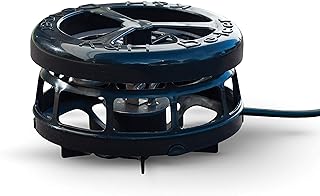
The new Perfect Climate line from
K&H Manufacturing has reinvented the wheel when it comes to
keeping ice free water available in winter ponds.
Every K&H de-icer is safe in all ponds, unlike many of the other
de-icers available in the market today.
Every one of our de-icers can be used as a floating de-icer
out of the box or in seconds converts to a submersible de-icer
with the click of a button.
In the past, all that was readily available were energy gulping
1000 watt to 1500 watt de-icers; pond owners had no choice but
to purchase these expensive to run de-icers, even when they
didn't need it.
They solved this problem by creating a whole line of de-icers
along with a convenient zone chart for consumers to choose the
correct de-icer, every time. When it comes to ice free ponds,
K&H Perfect Climate is the choice that makes cents.
|
1500-Watt
Sinking Tank & Pond Heater with Guard
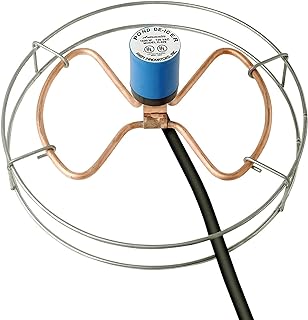
Sinking de-icer will sink to the bottom of the tank Thermostatically
controlled with an automatic shutoff
Each unit comes with a galvanized wire guard/stand; with the
guard in place, the sinking de-icer may be used in plastic tanks
Since it operates at the bottom of the tank, it is less likely
to be disturbed by livestock
Operates at 1500 watts, 120 volts |
Thermo-Pond
3.0
Floating Pond 100-Watt De-Icer
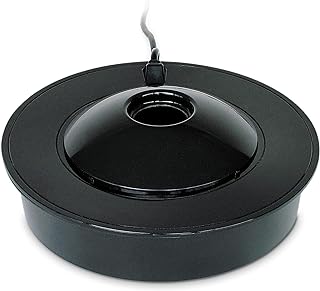
For ponds up to 1000 gallons.
The world-foots most energy efficient pond heater. Thermo-Pond
is a unique patented pond heater that keeps a hole through the
ice in backyard ponds for just pennies a day. In fact, Thermo-Pond
can save up to $30.00 a month in electricity VS. Those high
wattage stock tank style de-icers.
Just think, Thermo-Pond pays for itself in as little as 2 months.
Thermo-Pond floats on top of the water and is thermostatically
controlled to never get hot. Unlike some other heaters,
Thermo-Pond will never burn a pond liner or plastic pond. It
naturally allows the pond to ice over while maintaining a hole
through the ice. Allowing that gas exchange can help keep a
healthier environment during the winter months
Thermo-Pond should be used in ponds that are deep enough to
allow plenty of livable water under the iced portion of the
pond.
One year limited warranty.
|
|
Recommended
Books on Lake and Pond Management
These links go to the Amazon Bookstore
and as affiliates we may earn a commission if you purchase
one of these guide books.
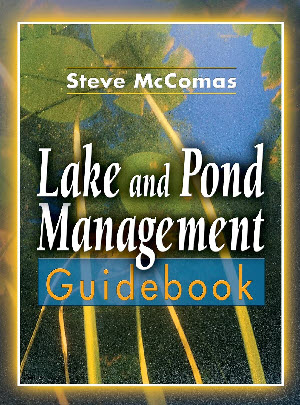 Lake
and Pond Lake
and Pond
Management Guidebook
The Lake and Pond Management Guidebook is the successor
to the best-selling Lake Smarts: The First Lake Maintenance
Handbook, the "bible" for small-scale lake and pond improvements,
published by the Terrene Institute in 1993.
Completely revised and updated, now published by Lewis Publishers,
this guidebook contains over 300 ideas and projects including
step-by-step practical, low-cost solutions to a wide range
of problems that lake management professionals face everyday.
Coverage includes shoreline buffer installation, fisheries
management, reducing nuisance algal growth, controlling exotic
aquatic plants, lakeside wastewater treatment systems, small
scale dredging, and more.
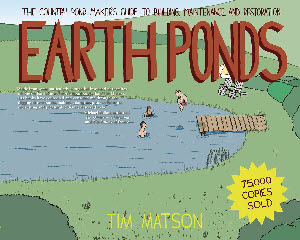 Earth
Ponds Earth
Ponds
The Country Pond Maker's Guide to Building,
Maintenance and Restoration
What else can simultaneously increase your aesthetic pleasure,
offer recreational opportunities, help the environment, and
increase the value of your land?
This is the recognized standard on ponds, now expanded to
include a comprehensive guide to living happily with your
completed pond and keeping it perpetually healthy.
Here is everything you need to know about planning, digging,
sculpting, and maintaining your pond.
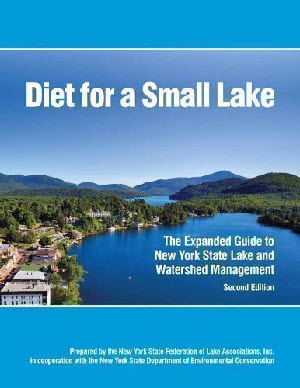 Diet
for a Small Lake Diet
for a Small Lake
The Expanded
Guide to Lake and Watershed Management
The expanded guide to New York State lake and watershed management,
2nd edition. Lake associations and citizens play a vital role
in protecting and restoring our lakes and waterways.
This book is an introduction to understanding and managing
lakes. Lakes and their watersheds are natural treasures for
us to use and protect.
Together these rich resources supply abundant water to support
thriving communities, provide recreational opportunities,
and spur economic growth in an area.
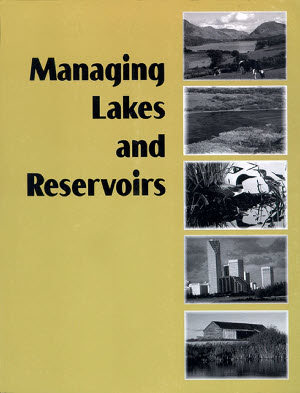 Managing
Lakes and Reservoirs Managing
Lakes and Reservoirs
Understandable and useful, Managing Lakes and Reservoirs addresses
the enormous amount of information on lake management that
has developed in the decade since the publication of the manualís
first two editions (Lake and Reservoir Restoration Guidance
Manual, 1988 and 1990).
The first two manuals dealt primarily with restoration of
lakes, but this third edition moves beyond restoration issues
to focus on ongoing management of lakes and processes that
communities of citizens, policymakers, scientists, and enforcement
agencies can use to achieve desired outcomes for their local
lakes.
Distributed for the North American Lake Management Society
Our
Favorite Books on Amazon On Ponds

As an Amazon
affiliate we may recieve payment for purchases made through
Amazon.
|
Email us for information or with your questions.
 Pond
Report Store Pond
Report Store
The
pond report also has information on:
Algaecides
& Bacteria | Deicers
& Bubblers | Weed
Removal | Liquid
Bacteria | Pond
Pumps & Fountains | Aeration
| Winter
Pond Care | Algae
Control | Pond
Liner | Muck Pellets |
Build
a Solar Aerator | Rotary
Vane Compressors | Floating
Fountains
| Building
a Pond | Linear
Air Compressors & Pumps | Weighted
Airline | Diffusers
& Airstones | Solar
Aeration Systems | DC
& Battery Operated Pumps | Windmill
Aeration | Dock
Bubbler Packages | Building
a Waterfall |
Dyes & Colorants | Consultations
| Questions &
Answers
| Links
& Resources | Eurasian
Milfoil
| |
Mosquito Control | Pondkeeper
Treatments | Aeration
Systems | Septic
Bacteria | Grease
Trap Blocks | Compost Aeration | Dissolved
Oxygen Meters | SOTR
& Pumping Rates |
Portable
Generators |
Duckweed Control
|
Pond
Plans & Pond Building Books & Guides |
© 2007
- 2024 The Pond Report
about
us | privacy
policy | contact
us
|











 Lake
and Pond
Lake
and Pond  Earth
Ponds
Earth
Ponds Diet
for a Small Lake
Diet
for a Small Lake Managing
Lakes and Reservoirs
Managing
Lakes and Reservoirs